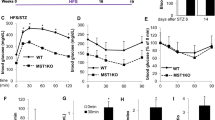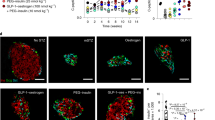Abstract
Streptozotocin, which produces diabetes mellitus in experimental animals1–3, has been reported to reduce the level of NAD in pancreatic islets4,5 and to inhibit islet synthesis of proinsulin6. The decrease in NAD is due to increased NAD degradation mediated by islet nuclear poly(ADP–ribose) synthetase7,8. Evidence suggests that poly(ADP–ribose) synthetase is activated when DNA is fragmented9–17. Here we describe that both Streptozotocin and alloxan, which also produces experimental diabetes mellitus1,2, cause DNA strand breaks which stimulate nuclear poly(ADP–ribose) synthetase, thereby depleting intracellular NAD and inhibiting proinsulin synthesis in isolated pancreatic islets of rats.
This is a preview of subscription content, access via your institution
Access options
Subscribe to this journal
Receive 51 print issues and online access
$199.00 per year
only $3.90 per issue
Buy this article
- Purchase on Springer Link
- Instant access to full article PDF
Prices may be subject to local taxes which are calculated during checkout
Similar content being viewed by others
References
Rerup, C. C. Pharmac. Rev. 22, 485–518 (1970).
Dulin, W. E. & Soret, M. G. in The Diabetic Pancreas (eds Volk, B. W. & Wellmann, K. F.) 425–465 (Plenum, New York, 1977).
Agarwal, M. K. FEES Lett. 120, 1–3 (1980).
Ho, C.-K. & Hashim, S. A. Diabetes 21, 789–793 (1972).
Hinz, M., Katsilambros, N., Maier, V., Schatz, H. & Pfeiffer, E. F. FEBS Lett. 30, 225–228 (1973).
Maldonato, A., Trueheart, P. A., Renold, A. E. & Sharp, G. W. G. Diabetologia 12, 471–481 (1976).
Yamamoto, H. & Okamoto, H. Biochem. biophys. Res. Commun. 95, 474–481 (1980).
Okamoto, H. Molec. cell. Biochem. 37, 43–61 (1981).
Miller, E. G. Biochim. biophys. Acta 395, 191–200 (1975).
Berger, N. A., Weber, G. & Kaichi, A. S. Biochim. biophys. Acta 519, 87–104 (1978).
Smulson, M. E., Schein, P., Mullins, D. W. Jr & Sudhakar, S. Cancer Res. 37, 3006–3012 (1977).
Jacobson, M. K., Levi, V., Juarez-Salinas, H., Barton, R. A. & Jacobson, E. L. Cancer Res. 40, 1797–1802 (1980).
Berger, N. A., Sikorski, G. W., Petzold, S. J. & Kurohara, K. K. Biochemistry 19, 289–293 (1980).
Skidmore, C. J. et al. Eur. J. Biochem. 101, 135–142 (1979).
Durkacz, B. W., Omidiji, O., Gray, D. A. & Shall, S. Nature 283, 593–596 (1980).
Ohgushi, H., Yoshihara, K. & Kamiya, T. J. biol. Chem. 255, 6205–6211 (1980).
Benjamin, R. C. & Gill, D. M. J. biol. Chem. 255, 10502–10508 (1980).
Whish, W. J. D., Davies, M. I. & Shall, S. Biochem. biophys. Res. Commun. 65, 722–730 (1975).
Smulson, M., Stark, P., Gazzoli, M. & Roberts, J. J. Expl Cell Res. 90, 175–182 (1975).
Halldorsson, H., Gray, D. A. & Shall, S. FEBS Lett. 85, 349–352 (1978).
Noto, Y. & Okamoto, H. Acta diabetol. lat. 15, 273–282 (1978).
Itoh, N. & Okamoto, H. Nature 283, 100–102 (1980).
Lacy, P. E., McDaniel, M. L., Fink, C. J. & Roth, C. Diabetologia 11, 501–507 (1975).
Claycomb, W. C. Biochem. J. 154, 387–393 (1976).
Levi, V., Jacobson, E. L. & Jacobson, M. K. FEBS Lett. 88, 144–146 (1978).
Lazarow, A. Proc. Soc. exp. Biol. Med. 61, 441–447 (1946).
Heikkila, R. E., Winston, B., Cohen, G. & Barden, H. Biochem. Pharmac. 25, 1085–1092 (1976).
Grankvist, K., Marklund, S., Sehlin, J. & Täljedal, I.-B. Biochem. J. 182, 17–25 (1979).
Fischer, L. J. & Hamburger, S. A. Diabetes 29, 213–216 (1980).
Parkhurst, J. R., Peterson, A. R. & Heidelberger, C. Proc. natn. Acad. Sci. U.S.A. 70, 3200–3204 (1973).
Berger, N. A., Weber, G., Kaichi, A. S. & Petzold, S. J. Biochim. biophys. Acta 519, 105–117 (1978).
Okamoto, H., Noto, Y., Miyamoto, S., Mabuchi, H. & Takeda, R. FEBS Lett. 54, 103–105 (1975).
Kissane, J. M. & Robins, E. J. biol. Chem. 233, 184–188 (1958).
Author information
Authors and Affiliations
Rights and permissions
About this article
Cite this article
Yamamoto, H., Uchigata, Y. & Okamoto, H. Streptozotocin and alloxan induce DNA strand breaks and poly(ADP–ribose) synthetase in pancreatic islets. Nature 294, 284–286 (1981). https://doi.org/10.1038/294284a0
Received:
Accepted:
Issue Date:
DOI: https://doi.org/10.1038/294284a0
This article is cited by
-
Desert date seed extract-loaded chitosan nanoparticles ameliorate hyperglycemia and insulin deficiency through the reduction in oxidative stress and inflammation
Scientific Reports (2024)
-
Protective effect of lactoferrin administration against brain tissue damage in diabetic rats
Journal of Umm Al-Qura University for Applied Sciences (2023)
-
Role of poly(ADP-ribose) polymerase-1 in regulating human islet cell differentiation
Scientific Reports (2022)
-
Congenic mapping and candidate gene analysis for streptozotocin-induced diabetes susceptibility locus on mouse chromosome 11
Mammalian Genome (2018)
-
Effect of nociceptin on insulin release in normal and diabetic rat pancreas
Cell and Tissue Research (2018)
Comments
By submitting a comment you agree to abide by our Terms and Community Guidelines. If you find something abusive or that does not comply with our terms or guidelines please flag it as inappropriate.



